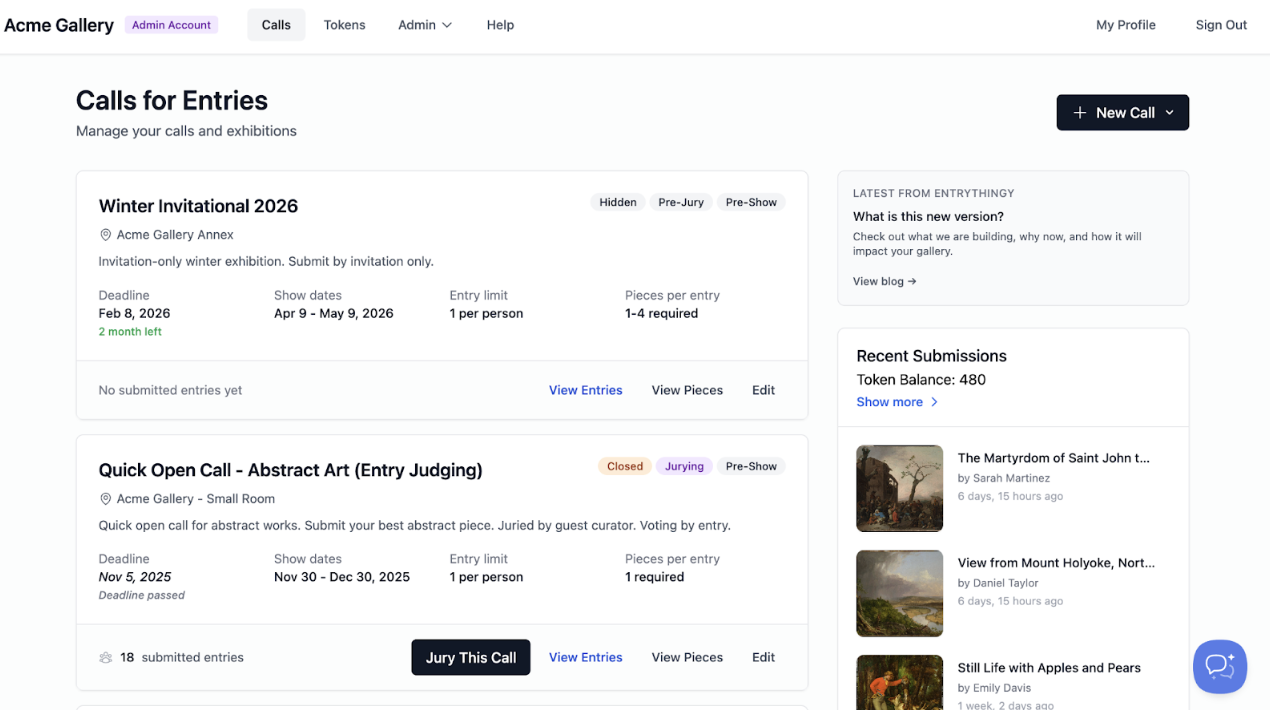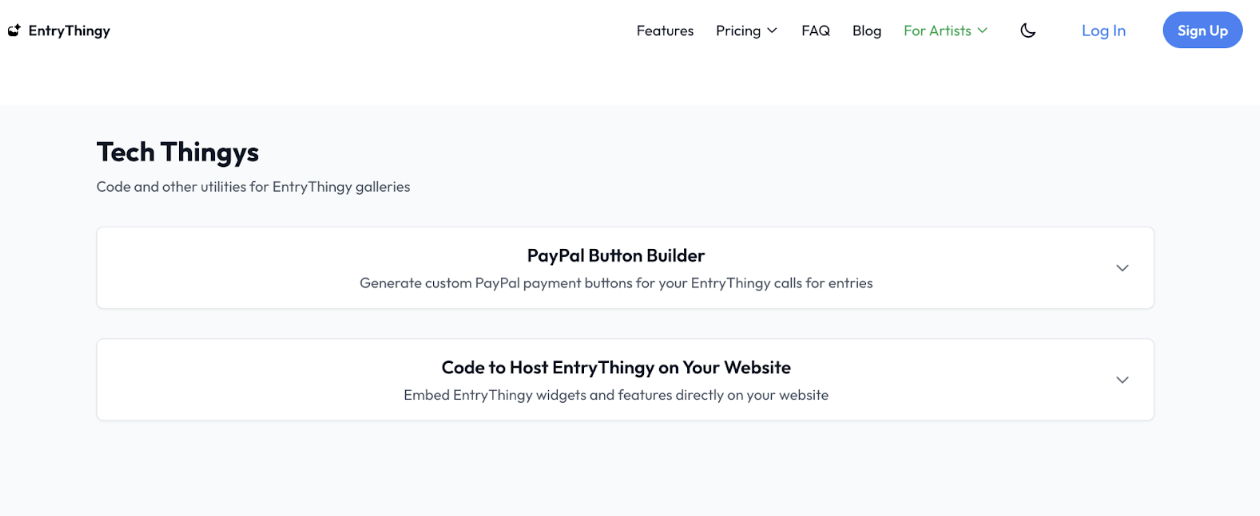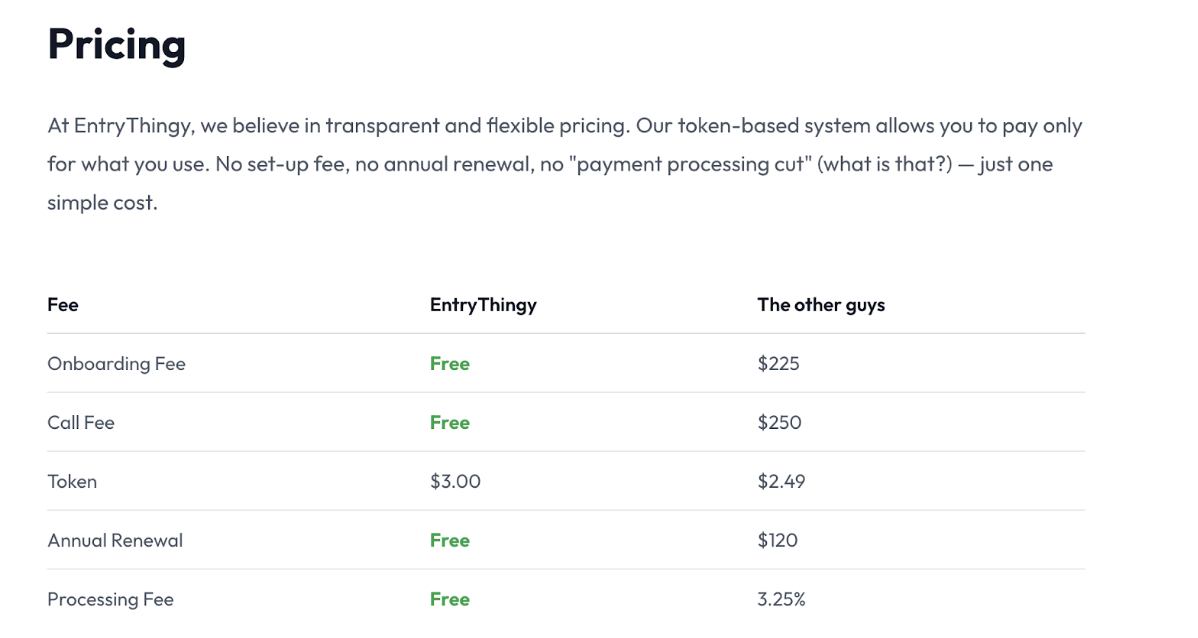Collecting artist payments is one of the most important parts of running an open call, exhibition, or art competition.
Whether you're accepting submission fees, booth payments, or jurying entries, you need a platform that’s reliable, transparent, and easy for both artists and admins to use.
In this guide, you’ll look at the best tools to collect artist payments, how each platform handles transactions, and what their pricing looks like.
You will also understand what makes EntryThingy different, especially its direct-to-gallery payment flow that gives you full control over your fees.
Comparison Table: Best Tools to Collect Artist Payments
| Tool | How Payments Work | Pricing Structure |
|---|---|---|
| EntryThingy | Artists pay directly into the gallery’s PayPal account; EntryThingy never touches or holds the funds. | Token-based: $3 per entry token. No onboarding fees. No platform percentage taken from artist fees. |
| Submittable | Payments are processed by Submittable; funds are remitted to the organization after fees. | Custom overall pricing. Publicly listed fee for paid submissions: $0.99 + 5% per transaction (4% covers processing). |
| CaFÉ | CaFÉ collects the artist’s payment, deducts fees, and pays the organization via scheduled payouts. | $225 onboarding. Then per-call pricing: $250–$475 per call, plus $2.49 per application (depending on plan). ~3.25% payment processing applies. |
| ArtCall | Payments flow directly into the organizer’s Stripe account; ArtCall does not handle the money. | Starts at $79 per call, increasing based on submission volume (tiered pricing). |
| ZAPPlication | ZAPP collects application/booth fees and remits funds on a monthly/scheduled basis. | $500–$1,500 setup, licensing fees $1,100–$2,700, plus $1.99–$6.99 per application and 2.95% + $0.30 credit card fees. |
5 Best Tools to Collect Artist Payments in 2026
1. EntryThingy - Best Overall Tool for Collecting Artist Payments

EntryThingy is trusted by more than 2,500 galleries and 166,000+ artists, and it’s built specifically for juried calls, gallery submissions, and exhibition applications. And now there is a new launch of the platform!
What sets it apart is not just the submission workflow, it’s the payment model.
EntryThingy handles payments in a fundamentally different way from most platforms in this space (including competitors like CaFÉ, which we review later in this article).
Most submission systems collect the artist’s entry fee first, hold the money, deduct their cut, and then pay the gallery at the end of the month.
This is standard, but it creates delays, reduces transparency, and gives galleries less control over the financial flow.
EntryThingy does the opposite. Let’s break down how payments work in EntryThingy and its pricing structure:
How Payments Work in EntryThingy
When an artist pays an entry fee, the money goes directly into your PayPal account. EntryThingy never touches or holds any payments, and it is not part of the financial transaction at all.

Entrythingy’s philosophy is simple: your artists, your entries, your revenue.
Because payments go straight to you:
- You get paid instantly
- There is no monthly payout cycle
- You maintain full visibility and control
- No percentage is taken from your artist fees
Pricing Structure

Instead of taking a cut of your revenue, EntryThingy uses a straightforward token model:
- 1 artist submission = 1 token
- 1 token = $3
- Tokens are the only cost paid to EntryThingy
Your entry fees remain entirely yours (minus standard PayPal processing fees).
EntryThingy simply charges organizations for the tokens that run the platform and stays completely separate from the fees you collect from artists.
How Entrythingy differs from others:
Want to see exactly how much you can save with EntryThingy? Use our interactive pricing comparison tool to compare costs based on your specific needs.
Quick Summary:
If you want a tool that gives you complete control over how artist payments are collected, with no intermediaries and no revenue sharing, EntryThingy is one of the most transparent and straightforward options available.
Its direct-pay approach removes delays, removes confusion, and keeps the financial relationship fully between you and your artists.
💡 Running open calls or exhibitions?
Join the galleries using EntryThingy to collect payments directly, manage submissions easily, and keep full control over your fees.
2. Submittable - Comprehensive Submission Platform (but Higher Cost)
Submittable is widely used across grants, scholarships, contests, nonprofits, and large arts organizations.
It’s polished and powerful, but because it’s not built specifically for art-only open calls, its payment flow and pricing model differ from platforms like EntryThingy.
How Payments Work in Submittable
When an artist pays an entry fee, the payment goes through Submittable’s own processing system, not directly into your gallery or organization’s account.
Here’s the flow:
- The artist pays inside the Submittable interface
- Submittable processes the payment
- Submittable deducts its fees
- The remaining funds are later paid out to your organization
This means Submittable acts as the intermediary between your artists and your revenue. You do not receive the money instantly, and you don’t control the payment flow directly.
Pricing Structure
Submittable’s platform pricing (subscription/licensing) is not publicly listed and varies by organization size.
However, their per-submission transaction fees are public:
- $0.99 + 5% of the total amount collected per paid submission
- 4% of that 5% goes toward Submittable’s processing costs
- Paid submissions do not count toward your submission limits
Because the fee is based on revenue, the more artists submit (or the higher your entry fee) the more you pay Submittable.
Most independent sources note that Submittable tends to cost significantly more than tools designed specifically for gallery-level open calls.
Quick Summary:
Submittable works well for large, multi-program organizations with complex application workflows, but for galleries running standard art calls, the indirect payment flow and scaling fees can make it less ideal compared to simpler, art-tailored tools.
3. CaFÉ (Call for Entry) - Popular in the Visual Arts Sector
CaFÉ is one of the most established submission platforms in the visual arts world.
It’s widely used by public-art programs, arts councils, and organisations that run large or government-funded calls.
The platform offers reliable jury tools and a familiar experience for artists who frequently submit to arts opportunities.
How Payments Work in CaFÉ
When artists apply through the platform, they pay their entry fees to CaFÉ, not directly to your organisation.
Here’s the payment flow:
- The artist submits through CaFÉ
- CaFÉ collects and processes the entry fee
- CaFÉ deducts its fees
- The remaining funds are sent to your organisation on their payout schedule
Because CaFÉ is the intermediary, payments do not land instantly in your account. You also don’t control the payment flow directly. The platform manages it from start to finish before releasing your portion.
This system is common for public-art programs, but it’s different from tools where payments go straight into your own payment account.
Pricing Structure
CaFÉ uses a combination of onboarding, annual, per-call, and per-application fees. Here’s the full breakdown:
- One-time onboarding: $225
- Annual account renewal: $120
- Pro Plan: $250 per call + $2.49 per application
- Plus Plan: $475 per call (includes first 250 submissions), then $2.49 per additional application
- Processing fees: approx. 3.25% on all artist payments
- Optional add-ons: email blasts, finalist modules, etc.
Your total cost is influenced by:
- How many calls do you run?
- How many artists apply
- Whether you need any optional services
Quick Summary:
CaFÉ is a dependable choice for large visual-arts programs, public-art commissions, and organisations that handle high-volume calls with structured jury workflows.
For smaller galleries or those hosting straightforward open calls, the onboarding fees, per-call costs, and payment-intermediary model may feel heavier than necessary. Especially if you prefer a platform where artist payments go directly into your own account.
Switching from CaFÉ? EntryThingy offers free data migration, meaning they can help move your call history and submission records so you don’t have to rebuild everything manually.
4. ArtCall - Flexible and Simple for Mid-Sized Gallery Calls
ArtCall is a cloud-based submission platform designed for galleries, art competitions, and community arts programs that want a clean, straightforward way to collect submissions.
It focuses on quick setup, essential tools, and a minimal learning curve, making it a practical choice for mid-sized open calls that don’t require enterprise-level complexity.
How Payments Work in ArtCall
With ArtCall, you set your own entry fees and connect your payment processor (typically Stripe).
When an artist submits and pays:
- The artist pays through your Stripe integration
- The payment goes directly into your Stripe account
- ArtCall does not hold or touch the funds at any point
This gives organizers direct control over payments, similar to EntryThingy, and avoids delays or platform-managed payout cycles.
Pricing Structure
ArtCall uses a tier-based “pay per call” model:
- Pricing starts at $79 per call for smaller programs
- Higher tiers apply as your expected submission volume increases
- Your cost depends on how many entries you anticipate for that specific call
There is:
- No per-entry fee taken by ArtCall
- No subscription requirement
- Only standard Stripe processing fees apply
This makes costs predictable if your calls are typically mid-sized, though pricing can increase for higher-volume events.
Quick Summary:
ArtCall is a solid fit for galleries that want a simple, pay-per-call structure and direct payment flow without ongoing subscription costs. It’s easy to set up and works well for mid-sized calls.
However, if you need predictable per-entry costs or a more transparent financial model across multiple calls, a platform like EntryThingy may offer better long-term cost control and flexibility.
5. ZAPPlication (ZAPP) - Built for Art Fairs & Large Events
ZAPPlication is built primarily for art fairs, festivals, and large public events rather than traditional gallery-style open calls.
It helps organisers manage applications, booth fees, exhibitor payments, and jury processes at scale.
If you’re running an event with hundreds of artists or vendors, ZAPP provides the kind of infrastructure smaller tools don’t offer.
The biggest difference between ZAPP and artist-call platforms is that payments flow through ZAPP first, not directly to the organiser.
How Payments Work in ZAPP
When an artist or exhibitor submits an application or pays for booth space, the payment is processed through ZAPP’s own system, not directly into your account.
Here’s the flow:
- The artist pays inside ZAPP
- ZAPP processes the transaction
- ZAPP deducts licensing, setup, or per-application fees
- The remaining funds are later paid out to the organiser
This means ZAPP acts as the intermediary for all financial transactions. Payments do not land in your account instantly.
Pricing Structure
ZAPP’s pricing depends on the size of your event and includes setup fees, licensing fees, and per-application costs.
Their main plans include:
- Small Show Plan 1 (under ~150 applications): $500 setup + $1,100 licensing + standard card fees (2.95% + $0.30)
- Small Show Plan 2 (151–499 applications): $500 setup + $6.99 per application + card fees
- Standard Show (500+ applications): $1,500 setup + $2,700 licensing + $1.99 per application + card fees
There are also optional add-ons like booth management, email blasts, and advanced jury tools.
ZAPP’s model works well for large, complex events, but it can be expensive and less flexible for smaller calls, especially because payments do not go directly to the organiser at the moment of purchase.
Quick Summary:
ZAPPlication is a strong choice if you’re running large art fairs or festivals with exhibitors, booth assignments, maps, vendor tools, and thousands of attendees. Its full event-management ecosystem is something traditional gallery platforms don’t offer.
But if your organisation runs gallery-style open calls and you prefer a direct payment flow (artist → your account) with simpler pricing, a platform like EntryThingy will be much more transparent and easier to manage.
Collect Artist Payments Faster, Cheaper, and More Transparently with EntryThingy
Collecting artist payments can become more complicated than necessary when platforms hold funds or deduct fees before paying you.
EntryThingy avoids all of that by keeping the payment flow simple.
When an artist pays, the money goes directly into your PayPal account. Nothing is held, nothing is deducted, and you always know where your revenue is.
Here’s what EntryThingy ensures every time:
- Payments go straight to you
- No platform percentage taken
- No payout delays
- Clear, predictable costs
For galleries that want a transparent and easy-to-manage payment setup, EntryThingy keeps the entire process straightforward from start to finish.
💡 Running open calls or exhibitions?
Join the galleries using EntryThingy to collect payments directly, manage submissions easily, and keep full control over your fees.